Oregon (Dark-eyed) Junco – Passeriformes Emberizidae Junco hyemalis
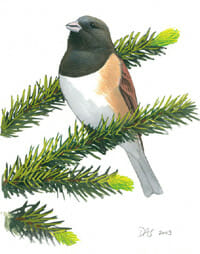 |
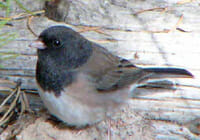 |
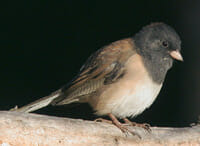 |
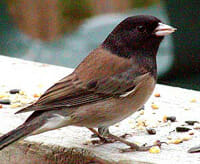 |
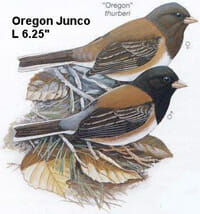 |
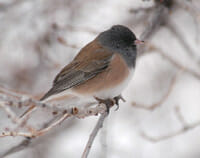 |
Identification & Description:
• Medium-sized sparrow.
• Pink, conical bill
• White outer tail feathers
• Considerable geographic variation in plumage
• Various forms were formerly considered separate species
• Unstreaked gray or brown, no wingbars (usually).
• Gray to black hood.
• Belly white.
• Eyes dark. Legs pink.
• Size: 14-16 cm (6-6 in)
• Wingspan: 18-25 cm (7-10 in)
• Weight: 18-30 g (0.64-1.06 ounces)
“White-winged junco”:
• Medium gray head, breast and upperparts
• White belly
• White wing bars
• Female and immatures somewhat browner than male
• Breeds from Montana to Nebraska
“Oregon junco”:
• Dark gray head and breast
• Brown back and wings
• Buffy flanks
• White belly
• Female and immatures somewhat duller than male
• Breeds from Alaska to California
“Slate-colored junco”:
• Dark gray head, breast and upperparts
• White belly
• Female and immatures somewhat browner than adult male and may have buffy flanks
• Breeds in eastern United States and Canada
“Pink-sided junco”:
• Medium gray head and breast
• Dark lores
• Brown back and wings
• Pinkinsh flanks
• White belly
• Female and immatures somewhat browner than male
• Breeds from Alberta to Idaho
“Gray-headed junco”:
• Medium gray plumage, palest on belly
• Rusty back
• Dark lores
• Sometimes has dark upper mandible
• Breeds in Rocky Mountains
Similar species:
The Dark-eyed Junco is similar to the local (southeast Arizona) Yellow-eyed Junco but has dark eyes. Black-chinned sparrow has streaked back, brown wings and lacks white in the tail.
Life History Groupings
• Migration Status: Short distance migrant
• Breeding Habitat: Woodland
• Nest Location: Ground-low nesting
• Nest Type: Open-cup
• Clutch Size: 3-5
• Length of Incubation: 12-13 days
• Days to Fledge: 9-13
• Number of Broods: 2, occasionally 3 in south, 1 at high elevation and latitude
• Diet:
Primarily: Seeds
Lesser Quantities of: Insects
Facts
• Juncos are the “snowbirds” of the middle latitudes. In the eastern United States, they appear in all but the most northern states only in the winter, and then retreat each spring. Some juncos in the Appalachian Mountains remain there all year round, breeding at the higher elevations. These residents have shorter wings than the migrants that join them each winter. Longer wings help the migrants fly long distances.
• The Dark-eyed Junco includes five forms that were once considered separate species. The “slate-colored junco” is the grayest, found from Alaska to Texas and eastward. The “Oregon junco” is boldly marked blackish and brown, with a distinct dark hood, and is found in the western half of the continent. The “gray-headed junco” has a brown back and gray sides and lives in the central Rocky Mountains. The “white-winged junco” is all gray with white wingbars, and breeds only near the Black Hills of South Dakota. The “Guadalupe junco” of Baja California is dull and brownish. Two other forms may be distinguishable: the “pink-sided junco,” a pale version of the Oregon junco, living in the northern Rocky Mountains, and the “red-backed junco,” a gray-headed junco with a dark upper bill, found in mountains near the Mexican border.
• The Dark-eyed Junco is a common bird at winter bird feeders across North America. Data from Project FeederWatch show that it is often the most common feeder bird in an area, and it is on the top-ten lists of all regions except the Southeast and South-Central (where it is 11th and 12th, respectively).
Other Names
Junco ardoisé (French)
Junco ojo oscuro (Spanish)
Juncos make up the genus Junco in the family Emberizidae. The dark-eyed junco is classified as Junco hyemalis, the “slate-colored” dark-eyed junco as Junco hyemalis hyemalis, and the “Oregon” dark-eyed junco as Junco hyemalis oreganus. The yellow-eyed junco is classified as Junco phaeonotus, and the volcano junco is classified as Junco vulcani.
Junco, common name for three finch species that are particularly adept at cracking open seeds. Some subspecies of the widely distributed dark-eyed junco may prove to be distinct species. The “slate-colored” dark-eyed junco breeds from Alaska east to Newfoundland and Labrador and New England, wintering south to northern Mexico and the Gulf states. It is about 15 cm (6 in) long. Adult males are slate gray, with a white abdomen and white outer tail feathers. Females and immatures are browner. Males of the “Oregon” dark-eyed junco have black or gray heads and rusty backs. A paler species, the yellow-eyed junco, is confined to Mexico and the southwestern United States. The third species, the volcano junco, has a brown and black streaked back, looking more sparrowlike. It is found only on high mountains of Costa Rica and Panama.